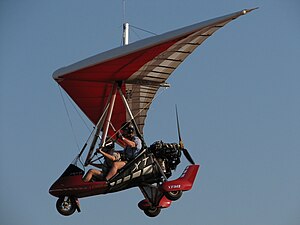Airborne XT
 From Wikipedia - Reading time: 5 min
From Wikipedia - Reading time: 5 min
| XT Series | |
|---|---|

| |
| Airborne XT-912 Tourer | |
| Role | Ultralight trike |
| National origin | Australia |
| Manufacturer | Airborne Windsports |
| Introduction | 2003 |
| Status | In production |
| Produced | 2003-present |
| Developed from | Airborne Outback |
The Airborne XT is an Australian series of two-seat flying wing ultralight trikes designed and produced by Airborne Windsports and introduced in 2003.[1]
Design and development
[edit]The XT series features an XT carriage and a cable-braced hang glider-style high-wing, weight-shift controls, a two-seats-in-tandem open cockpit, tricycle landing gear and a single engine in pusher configuration.[1]
The wing is made from bolted-together aluminium tubing, with its double surface wing covered in Dacron sailcloth. Its 9.9 m (32.5 ft) span wing is supported by a single tube-type kingpost and uses an "A" frame control bar. A number of different wings are available for the series. The XT was the first carriage used by Airborne that incorporated landing gear shock absorbers. It also uses a gas strut to lower and raise the wing for rigging it. Powerplants include the 80 hp (60 kW) Rotax 912 four cylinder, four stroke, horizontally-opposed aircraft engine and the 64 hp (48 kW) Rotax 582 twin cylinder, two stroke, inline engine.[1]
Variants
[edit]- XT-912 Streak 2
- Initial version with 60 kW (80 hp) Rotax 912 engine, Streak 2 wing and cockpit fairing, introduced in 2003.[1]
- XT912-SST Tundra
- Model with 60 kW (80 hp) Rotax 912 engine and SST strut-braced wing, cockpit fairing and tundra tires for off-airport operations.[2][3]
- XT-912 Tundra
- Model with 60 kW (80 hp) Rotax 912 engine and Streak or Cruze model wing, cockpit fairing and tundra tires for off-airport operations.[2]
- XT-912 Tourer
- Model with 60 kW (80 hp) Rotax 912 engine and Streak or Cruze model wing and cockpit fairing.[2]
- XT-912 Outback
- Development of the Airborne Outback model with 60 kW (80 hp) Rotax 912 engine tundra wheels, 70 litres (15 imp gal; 18 US gal) fuel tank and GX instrument package and no cockpit fairing.[2][3]
- XT-582 Tourer
- Model with 48 kW (64 hp) Rotax 582 engine, Cruze model wing and cockpit fairing.[2][3]
- XT-582 Tundra
- Model with 48 kW (64 hp) Rotax 582 engine, tundra tires and cockpit fairing.[2]
- XT-582 Outback
- Development of the Airborne Outback model with 48 kW (64 hp) Rotax 582 engine, tundra tires and no fairing.[2]
Specifications (XT Streak 2)
[edit]
Data from Betrand[1]
General characteristics
- Crew: one
- Capacity: one
- Wingspan: 9.9 m (32 ft 6 in)
- Wing area: 15 m2 (160 sq ft)
- Empty weight: 216 kg (476 lb)
- Gross weight: 450 kg (992 lb)
- Fuel capacity: 62 litres (14 imp gal; 16 US gal)
- Powerplant: 1 × Rotax 912 four cylinder, four stroke, horizontally-opposed aircraft engine, 60 kW (80 hp)
Performance
- Maximum speed: 120 km/h (75 mph, 65 kn)
- Stall speed: 56 km/h (35 mph, 30 kn)
References
[edit]- ^ a b c d e Bertrand, Noel; Rene Coulon; et al: World Directory of Leisure Aviation 2003-04, page 94. Pagefast Ltd, Lancaster OK, 2003. ISSN 1368-485X
- ^ a b c d e f g Airborne Windsports (2011). "Airborne Microlight Range". Retrieved 15 January 2012.
- ^ a b c Bayerl, Robby; Martin Berkemeier; et al: World Directory of Leisure Aviation 2011-12, page 202. WDLA UK, Lancaster UK, 2011. ISSN 1368-485X
 KSF
KSF